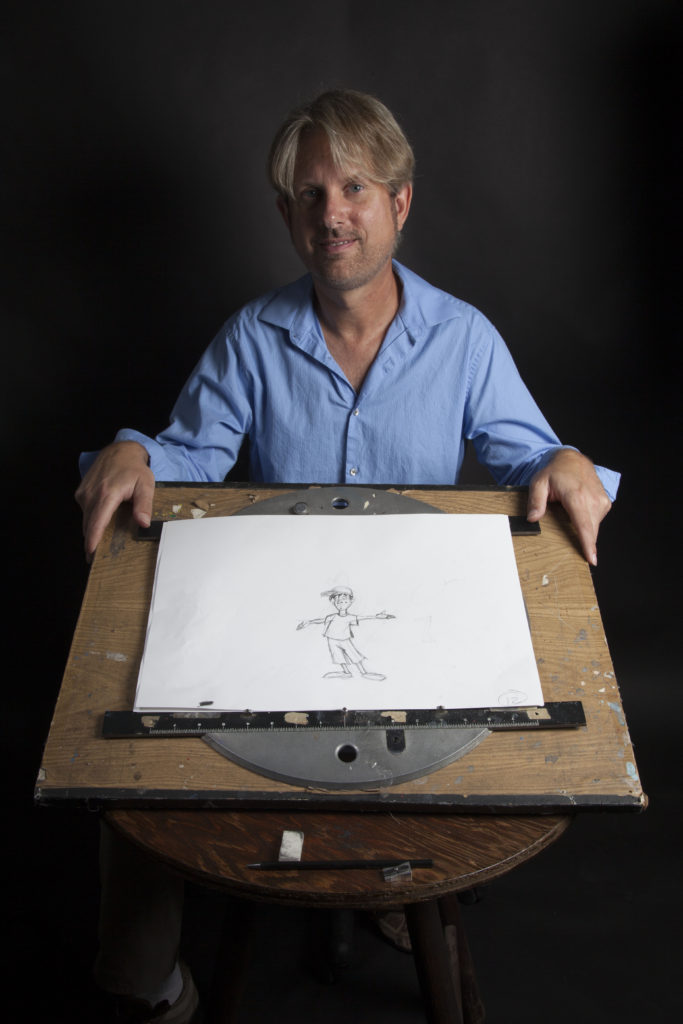
It starts with a blank sheet of paper. Concentrating, while a cascade of ideas release from the lead of a pencil onto the page, is how animation begins.
Animator Scott Claus used to work on one drawing an hour, sometimes for 10 to 12 hours.
Born and raised in Oregon, Claus studied motion pictures and television at the University of Oregon in Eugene before moving to Los Angeles. The animator has created films, musicals and novels, but started teaching about his field in various colleges in 2013.
“I knew from the minute I was born it was something I really wanted to do,” Claus says. “I saw movies and television and I saw how animation was done and I immediately started training and started my own animation.”
Claus worked at Disneyland as a Jungle Cruise operator, and from there, he began looking into editing.
“I loved Disneyland. That’s why I wanted to work there. I wanted to work in a place where it’s magic,” Claus says. “I wouldn’t have done any of this if it weren’t for that opportunity.”
Claus worked his way up to Disney Feature Animation and DreamWorks. He said he didn’t feel like he was at work because he loved what he was doing.
Some of the first films Claus worked on was Prince and the Pauper in 1990 and Swan Princess in 1994 as an assistant animator. Claus had an opportunity to work with Pixar animation in the 1990’s, but passed because he wasn’t interested in the new technology they were using.
In the 1990’s, Claus worked on the Disney films Pocahontas, The Hunchback of Notre Dame, Hercules and Tarzan.
“It was roughly 12 hours, and this was just drawing, no computers, 12 drawings per second, and that’s just for one character,” Claus says. “If there were two characters, we had to do 24 drawings per second.”
One of the first characters Claus worked on was Pocahontas. Claus says he used to draw her character everyday, about 50 hours a week.
Part of Claus’ profession is using storyboards and creating multiple images and frames that give an illusion of movement when displayed in rapid sequence. This is the process of animation.
“They’ll do the whole movie first, using what they call animatics storyboards, and they’ll take sections of it and give it to us and then we animate it,” Claus says.
In 2002, Dreamworks and Disney announced their transition to computer animation. Fortunately for Claus, he had already started learning these new programs because he was practicing before they announced the new transition.
“Dreamworks and Disney said to their employees, ‘If you don’t learn how to use computer animation you no longer have a job,’” Claus says. “As long as you pay attention to what’s going on in the universe, don’t be so stuck on what’s going on now. Look around and see what’s happening.”
Claus was part of the team that won an Oscar for visual effects for the film Life Of Pi in 2013. The film took three years to complete and Claus personally worked on the film for six months.
“My job on that film was to be in between the directors and a team of artists,” Claus says. “I would represent those teams of artist to the director.”
Claus attended the Annie Awards in 2013 where they won for Best Character Animation in a Live Action Production for Life of Pi.
Claus worked on the characters called Manticore and Centaur as an international animation supervisor for the 2013 film Percy Jackson Sea of Monsters. Claus personally created the cyclops character, Tyson.
Claus went through a few hurdles in his career that almost made him give up on animation. Shark Tale and Yogi Bear were Claus’ least favorite films that he worked on. He lost interest in projects that didn’t match with him, but continued until the film was over.
Retiring was not on Claus’ mind just yet, but as soon as he was sitting next to a 23-year-old fresh out of college, he realized it was time to move on.
“I couldn’t stay where I was and it was time for me to do something different,” Claus says. “So I thought to myself what I could do. I’d like to teach and pass on what I know to the next generation. Not just skills, and animation, I want them to know what they’re going to face in Hollywood.”
When Claus was younger, he wanted to be like director, producer and editor Steven Spielberg.
“I was a Star Wars baby and I saw all those films and I thought to myself, I want to do this when I grow up,” Claus says. “What I wanted to be all along is what I am now– a story teller.”
Claus also published multiple drawing books in his career. The sketches are drawings he drew and collected over the years.
“While I was working in animation, I spent a lot of time in meetings,” Claus says. “I would get bored and doodle in notebooks and someone told me to make books out of these.”
Claus also wrote, directed and produced musicals such as the 2015 musical Sin: A Pop Opera. He was inspired by director Ken Russell, who created the 1975 British musical film Tommy. The film is based on the 1969 rock opera album Tommy by The Who.
Sarah Kennedy, a California State University Long Beach graduate from the theater arts program, worked with Claus on the musical. The experience was both enjoyable and an eye-opener for Kennedy.
“Scott’s an awesome guy. He wrote the musical [Sin: A Pop Opera], so he had a very clear idea of what he wanted,” Kennedy says. “He showed us a couple of his animations and they were very unique. I learned a lot from working with him.”
When Claus started producing musicals, he realized he needed to work with someone who knew the business. That’s when he met Kay Cole.
Cole is a director and choreographer and teaches acting for film and television at Emerson College LA Annex and UCLA’s Musical Theatre Conservatory.
“We have similar work ethics. He was very fun to work with,” Cole says. “He’s a very creative and terrific writer and animator. I’ve seen all his films he’s worked on.”
Other than animating, Claus wrote three books. One of them is the 2014 novel My name is Christina Barry and I hate you. He was inspired to write this novel after not having a plan after college.
Claus’ favorite film that he worked on was the The Road to El Dorado for Dreamworks in 2000. He worked on the character Miguel. The film took about two years to complete.
“It’s really amazing to get to work all day to make people happy,” Claus says. “Making characters and bringing life to them.”
Giving up was something Claus didn’t want to do, but the constant critique of others made it difficult.
“It was hours of hard work and getting rejected and having people tell me I wasn’t good enough,” says Claus. “As long as you stay focused and do what you love, pay the rent, be patient, stay focused, it’s going to come.”
Claus says the reason he started teaching was to be the resource he wish he had when starting.
“You have to work really hard, you have to be passionate and you have to love what you’re doing and not listen to people who say no,” Claus says. “If you don’t feel that way about something, don’t do it. That’s the only way you’re going to survive.”
Claus says he wishes he had been more patient and persistent when he was younger. His advice for beginning animators would be to build relationships and not let one failure stop them from achieving their goals.
“You learn by making mistakes and not by succeeding,” Claus says. “You come to school to learn, get frustrated and make mistakes. So that when you get into the real world, it gets easier. Make sure you’re doing it because you love it. Don’t do it for the money. Don’t do it for the fame. Find that passion that you have and just keep doing that.”



